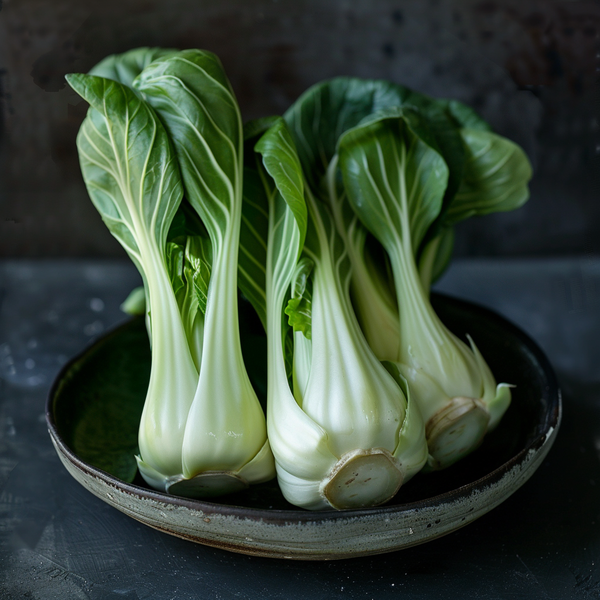
Bok Choy
Bok choy, also known as pak choi or Chinese cabbage, is a popular vegetable in Asian cuisine known for its crisp texture and mild, slightly sweet flavor. It consists of white stalks and dark green leaves, both of which are edible and nutritious. Here’s how bok choy is commonly used in cooking:
Stir-Fries: Bok choy is a staple in stir-fry dishes. It's typically chopped and added towards the end of cooking to retain its crispness and bright color. It pairs well with a variety of meats, tofu, and other vegetables, along with sauces like soy sauce, oyster sauce, or hoisin sauce.
Steamed: Steaming bok choy is a simple, healthy way to prepare it. It can be steamed whole or cut in half and served with a drizzle of soy sauce, sesame oil, and a sprinkle of sesame seeds or a dab of oyster sauce.
Soups and Broths: Bok choy can be added to soups and broths, contributing its mild flavor and nutrients. It cooks quickly and is often added towards the end of the cooking process. It's commonly found in Asian noodle soups and clear broths.
Braised: Braising bok choy in a flavorful liquid, such as chicken broth, garlic, and ginger, results in tender stalks and leaves infused with savory flavors.
Roasted: Roasting bok choy in the oven with a bit of oil and seasonings until the edges are crispy is an easy way to prepare it. This method concentrates its sweetness and adds a nice texture contrast.
Raw in Salads: The tender young leaves of baby bok choy can be used raw in salads. They add a crunchy texture and a fresh, mild flavor to mixed green salads or slaws.
Grilled: Halved or quartered heads of bok choy can be grilled, creating charred edges and a smoky flavor while keeping the interior tender and juicy.
In Dumplings and Rolls: Finely chopped bok choy can be used as a filling for dumplings, spring rolls, and other stuffed foods, often mixed with ground meat, shrimp, or tofu and seasonings.
As a Side Dish: Sautéed or blanched bok choy can be served as a simple, flavorful side dish, often enhanced with garlic, ginger, and a splash of soy sauce or sesame oil.
Pickled: Bok choy can be pickled as part of kimchi or on its own, creating a tangy, spicy condiment that adds flavor to a variety of dishes.
When cooking with bok choy, it's often recommended to separate the stalks and leaves, as the stalks take longer to cook. This ensures that both parts of the vegetable reach the desired tenderness without the leaves becoming overcooked. Bok choy's versatility and health benefits, including high vitamin A, vitamin C, and calcium content, make it a nutritious addition to a wide range of dishes.
Nutritional Information
calories
13
carbohydrates
2.18 g
fats
0.2 g
protein
1.5 g